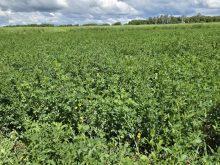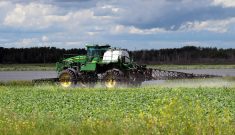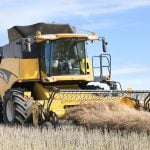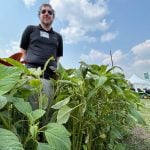Using off-the-shelf technology, spray applicators can deposit 100 percent more fungicide on cereal heads.
To put fungicide on wheat heads, applicators must ponder double nozzles, twin nozzles, forward angles, rearward angles, sprayer speed, droplet size and more.
The search for better methods began in 1998 with researchers at North Dakota State University. But the NDSU study had two shortcomings. They used a fine droplet size, which allowed too much spray drift and they limited their ground speed to eight-km/h (five mph).
Agriculture Canada researcher Tom Wolf said the logic was that the forward velocity of the sprayer should not be greater than the rearward velocity of the droplets coming out of the rear-facing nozzles.
Read Also
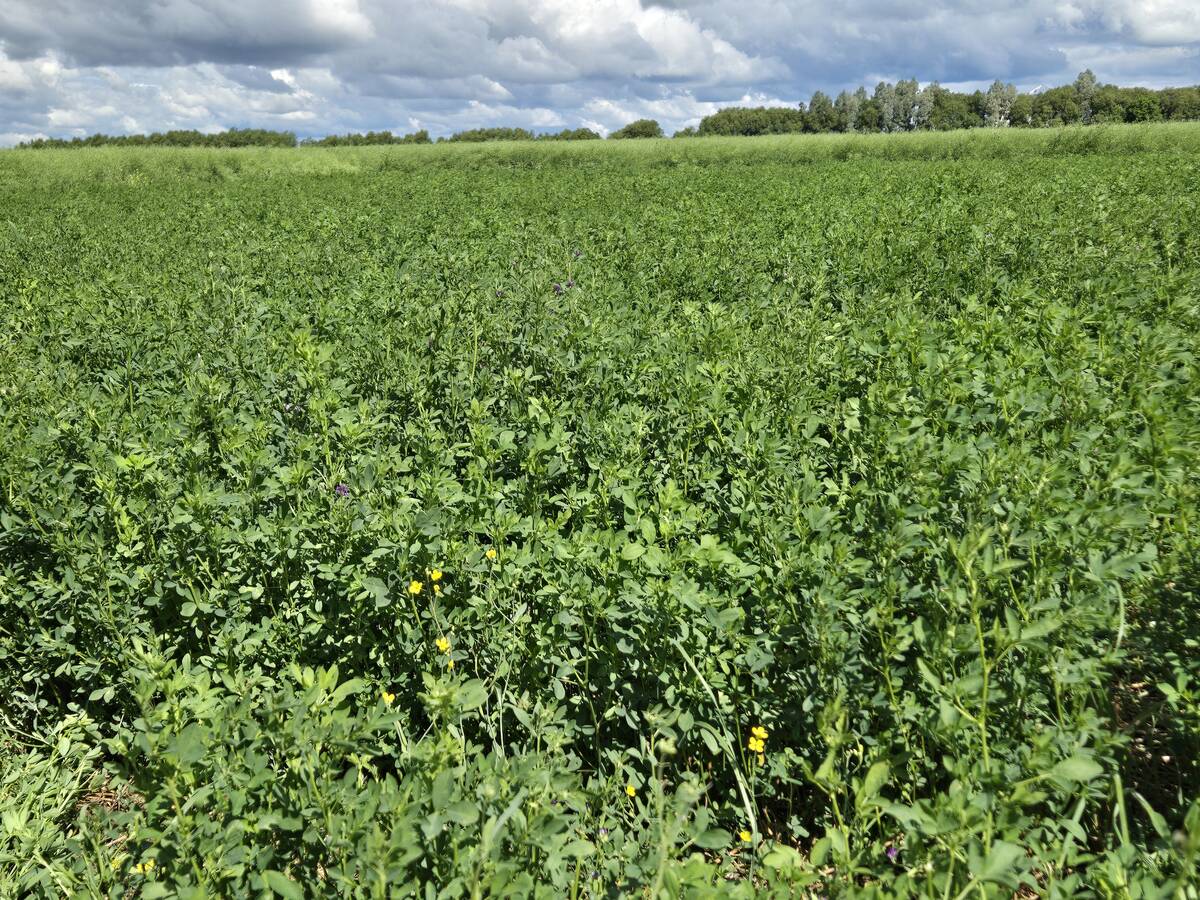
Manitoba Parkland research station grapples with dry year
Drought conditions in northwestern Manitoba have forced researchers at the Parkland Crop Diversification Foundation to terminate some projects and reseed others.
If the sprayer travels east faster than the rear facing droplets travel west, the net effect is that the rear facing droplets also travel east. Or if the two speeds match, it would be like spraying while standing still.
When scientists at Agriculture Canada in Saskatoon and the University of Guelph in Ontario heard about the NDSU research, they decided to take the challenge further.
Wolf said the fine droplet size is not only a drift problem but also a droplet velocity problem. The Saskatoon centre conducted fungicide application research with a variety of nozzles, angles and sprayer speeds six years ago.
The goal was to find the best combination for putting fungicide on a vertical head of wheat. The result was an increase of more than 100 percent in spray retention. Wolf said coarse droplets are a key element.
“The reason for coarser spray is that a big droplet has more momentum and has a better chance of hitting the intended target, regardless of what kind of nozzle,” said Wolf.
“If you spray a small droplet backwards and there’s a slight breeze, that droplet is lost almost immediately. The breeze takes it away.
“But a large droplet travels faster and stays on course longer. It not only has a greater likelihood of hitting the target, but just as important, it remains at the intended angle.”
When Wolf tried double nozzles with coarse droplets, he said chemical coverage on wheat heads significantly increased.
With double nozzles, he tried the coarse droplets facing forward and the fine droplets facing rearward and then switched the nozzles so they faced the opposite direction. The results showed that coarse droplets did a better job regardless of where they face.
To measure the contribution of both forward and rearward facing nozzles, he used a sophisticated double dye imagery system.
Does the forward nozzle only spray one side of the head and the rearward nozzle only spray the other side or do they share the workload?
“The net result of our tests is that the forward nozzle typically did more work than the rear facing nozzle.
“And both the forward and rearward nozzles contribute to coverage on both sides of the head. Up to a third of the spray from each nozzle wraps around to the opposite side. That’s simple aerodynamics at work.”
Double nozzles with coarse spray will do the best job of putting the product on the target, he said.
Ground speed is another important factor and Agriculture Canada’s work was at eight km/h (five mph) and 16 km/h (10 mph).
Wolf found the faster speed more effective, particularly for the forward facing nozzle. Travelling at 16 km/h (10 mph) had no detrimental impact on the effectiveness of the rear facing nozzles.
The first trials were run with the two nozzles pointing slightly forward at 30 degrees and slightly rearward at 30 degrees and were measured from a vertical axis down the centre between the two nozzles. This gave them 60 degrees of separation.
The next step was to make the angles more aggressive. The researchers went to 60 degrees forward and 60 degrees rearward from the vertical axis for a total separation of 120 degrees.
“The greater aggressiveness, both forward and backward, increased the deposition of chemical on the heads. That’s similar to the results they had at Ridgetown College (of the University of Guelph),” Wolf said.
All tests by Agriculture Canada at Saskatoon were run with a water volume of 17 gallons per acre, dictated by the nozzle sizes available.
Although some farmers and researchers use lower volumes, Wolf said the latest generation of fusarium headblight fungicides double as foliar fungicides and the higher water volume might be useful.
“For example, Folicur is a good foliar fungicide. Proline and others are also very good. So that means your secondary targets, the leaves, benefit from the full water volume to achieve good coverage, especially if they are lowering the canopy.”
Ridgetown researcher Art Schaafsma found that lower water volumes were more effective in fighting fusarium.
The higher volume used by Agriculture Canada in Saskatoon did a better job of putting product on the target, but Schaafsma thinks there’s a flip side.
The extra water, which forms a layer of dew on the plant, benefits the development of the disease. His observations ended up on the Bayer label for Folicur.
The growing season in the area around Guelph is more humid than the growing season on the Prairies. But Wolf said other findings at Ridgetown match the results from Saskatoon.
“They found that angling the nozzles forward and backward very aggressively was best. Their nozzles were almost straight forward and straight backwards,” said Wolf.
“They used Turbo Flood Jets. That’s an older style nozzle intended for liquid fertilizer. It’s not recommended for pesticides because it’s too coarse. But it seemed to work well with their fungicide studies.”
For applicators who don’t want double nozzles, things can be done to increase the fungicide cover sprayed through a single nozzle system.
Wolf said that in testing single nozzles, he angled them 30 degrees and 60 degrees from the vertical axis. He tried them facing forward and facing rearward. He tried two droplet sizes and also did the trial with nozzles facing straight down.
The conventional wisdom is that a forward facing nozzle is better than a rear facing nozzle.
Gary Moffat of Specialized Spray Systems, a research consultant and retailer in Lethbridge, has the opposite idea.
Moffat’s trials indicate that modern, high-speed sprayers with a single nozzle system give better uniformity of spray with the nozzle angled rearward. This work was done at speeds higher than the 16 km/h (10 mph) used in Saskatoon.
Moffat said modern high clearance sprayers are designed to run at 32 km/h (20 mph) or faster, so that’s the speed range in which he conducts his research.
Wolf said Agriculture Canada has not studied air canopy or air assist spray systems, but he supports the NDSU research.
“There is certainly a lot of scientific data showing that chemical deposition is enhanced. The air blast sweeps the plants aside momentarily to let the spray get in. It’s a controlled wind,” said Wolf.
In the battle to put chemical product directly onto a target, there are simple methods that have not yet reached Canada.
Ciba Gieigy in Europe once developed a device called the Tilt Bar to go with its fungicide Tilt. The Tilt Bar is a smooth round tube mounted slightly ahead of and below the boom.
It reaches the crop canopy just before the spray, bending the canopy forward and opening it up. The crop springs back just as the spray arrives.
The Tilt Bar never crossed the Atlantic.
“Some people say they won’t drive into a wheat head because of crop damage. So the location, shape of the bar and travel speed will be critical,” said Wolf.
The Slap Duk is a Swedish variation on the Tilt Bar. It’s a sloped plastic sheet that mounts ahead of and below the boom.
It bends the crop canopy forward as the boom approaches, much like the Manitoba-built Ag Shield Canola Pusher. As the crop springs back into place, it meets the oncoming spray.
The Crop Surfer was imported to North America from Sweden by Phil Needham of Needham Ag Technologies in Calhoun, Kentucky.
This plastic shield bends the crop forward so the spray can penetrate the canopy.
As the crop bounces back, it also creates a slight internal breeze that helps distribute the product.
Optimal fungicide application with dual nozzles is more of a concern in Manitoba where the fusarium problem is greatest.
However, producers in Saskatchewan and Alberta have contacted Wolf about adapting the angled dual nozzle technology for other pesticides.
Wolf’s research, Maximizing Spray Deposition on Wheat Heads: Effects of Nozzle Angle, Nozzle Type, Travel Speed and Double Nozzles, is available from Agriculture Canada.
For more information, contact Tom Wolf at 306-956-7635 or e-mail tom.wolf@agr.gc.ca.





